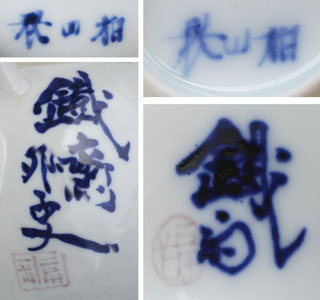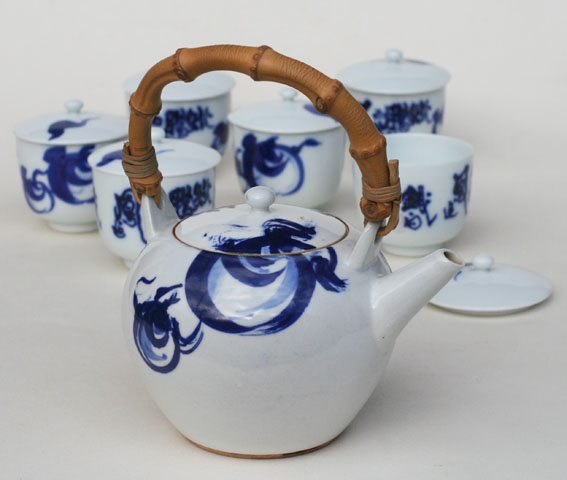chanoyu
Bunchaki set, teapot and 6 covered chawan, with tama decoration, Bun chaki setto kyūsu yunomiSigned: Tessai gaishi & Hakuzan sei
Seals: Tomioka
Technique: Kyoyaki sometsuke (Seikaji) - Translucent blue and white porcelain with a hand painted cobalt blue underglaze decoration.
茶銚 Chachô (teapot): Ø 14 x 11 (17)
茶器 Chawan (tea cups): 7 x 7,3 cm
The inscription reads: 欻騰龍而翕鳳追
’Smoothly the dragon rises quickly followed by the phoenix.’ A line from the Peiwen yunfu, "rime storehouse of esteemed phrases", a very large dictionary compiled during the Kangxi reign (1664-1722).
Tomioka Tessai was born in Kyoto into a family selling robes and accessories for the Buddhist clergy. As a result of a childhood illness he became partly deaf. It was therefore considered improbable that he would ever become a successful shopkeeper. Instead he went to study the Japanese classics in order to become a Shinto priest. He also did Chinese studies, specializing in the teachings of the neo-confucianist Wang Yang-Ming. Later he would study Buddhism, literature and Shingaku, a semi-religious system for self-cultivation. As a youth he met Ōtagaki Rengetsu (1791-1875) and became her special protégé. She taught him waka and encouraged his artistic inclinations. In the final years of the Tokugawa era Tessai was involved in the pro-imperialist movement. For fear of being arrested he left Kyoto in 1861 and travelled to Nagasaki. It was the first of many trips; Tessai became and avid traveller. In 1882 he settled in Kyoto where he spent the rest of his life. Although he worked as a priest at several Shinto shrines, he saw painting as his chief occupation. Between 1894 and 1904 he was a teacher at the Kyoto Prefectural Art School and he was a regular contributor to exhibitions of the Nanga Society. In 1917 he was appointed Artist to the Imperial Household and towards the end of his life he received an honorary court-rank. Tessai is often seen as the last great exponent of the Nanga school. (AB)
Reference:
Kanazawa
Kato 1998
Roberts p. 181
Araki pp. 2754-2755
Aburai pp. 266-267
Morioka & Berry ‘99 pp. 116-121 (# 20-21)
Morioka & Berry ‘08 p. 305-06 (# 11, 46)
Price: ON REQUEST

